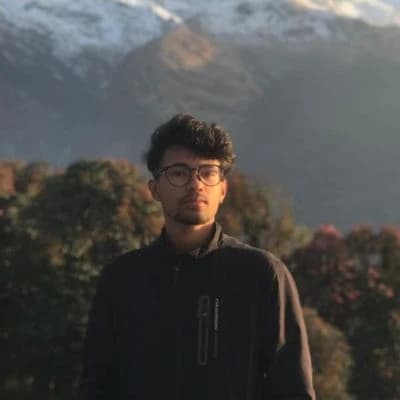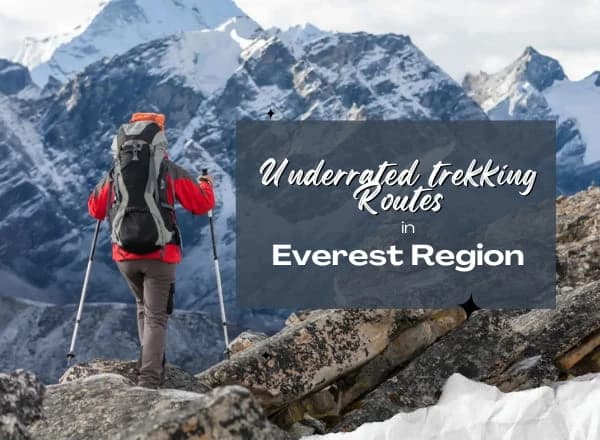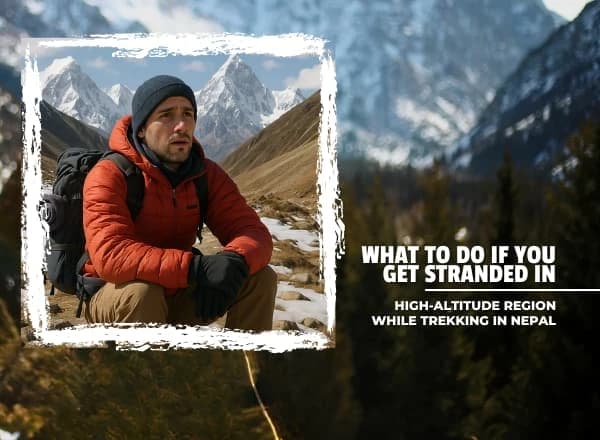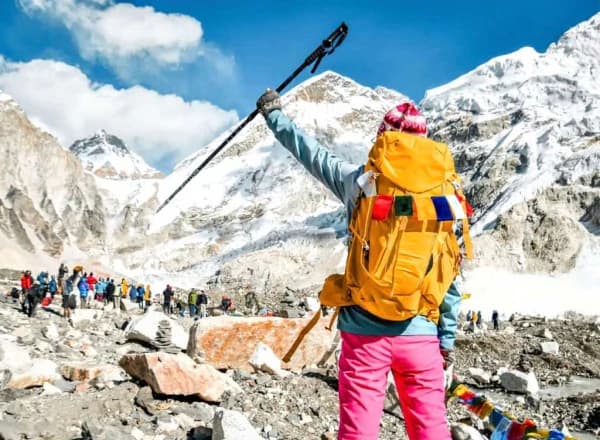Where is Nepal Situated in the World?

Geographically speaking, Nepal is a landlocked country located between two giant neighbors, both size-wise and economic-wise — India in the South, East, and West, and China (Tibet) in the North of the Asia Continent. It is located in the Himalayan Region, which has made its landscape one of a kind in the world, and the most picturesque country in the world.
- Capital City: Kathmandu, which has an estimated population of over 2 million and is also known as the “City of Temples,” has 7 UNESCO-listed world heritage sites.
- Latitude and Longitude: Nepal is located between 26° and 30° N latitude and between 80° and 89° E longitude.
- Time Zone: Nepal Standard Time (NST), which is GMT +5:45. This time is reciprocal to one of the Nepal's 7000-meter mountains named Gaurishankhar, a mountain east of Kathmandu that people consider sacred.
Having just a land area of 147,141 square km (56,812 square miles) it is the 95th largest country among 233 countries in the world according to Worldometer. Nepal's diverse geography ranges from the lowlands of the Terai region in the south its lowest is 60 meters in Jhapa to the majestic Himalayas in the north whose highest is 8849 meters Top of the World, making it an ideal place for every kind of traveler.
Where is Mount Everest located in Nepal?

Mount Everest, the highest peak in the world (8,848.86 meters), also known as Sagarmatha in Nepali, is located in Sagarmatha National Park, in the Solokhumbu District of Nepal, eastern part of the Capital city Kathmandu with an air distance of only 138km (85.7 miles). The name “Sagarmatha” is derived from two Nepali words: Sagar, meaning “sky,” and Matha, meaning “head”.
National Flag of Nepal and Its Meaning:
Nepal's national flag is one of the most unique and distinctive flags in the world, many say it is as unique as its country. Unlike any other national flag, it is neither square nor rectangular but made up of two stacked triangular shapes. Its design symbol and color are deeply interconnected with the country's history, culture, and religious beliefs. Here are some things about the Nepal flag and what it represents;

- Crimson Red Color: This color represents the bravery of Nepali people and it also symbolizes the rhododendron flower the national flower of Nepal.
- Blue Border: The blue border on the flag signifies peace and harmony in the country, which tells people in the country lives in peace and harmony.Two Triangles: Two triangles in the flag represent the Himalayan mountains and the country's two major religions, Hinduism and Buddhism. It is also said that the two triangles in the Nepal flag are derived from pagoda-style architecture found in Nepal's traditional temples and monuments.
- Sun and Moon: To Nepali people, it symbolizes that until there is a sun and moon in this world there will a our country Nepal. The moon symbolizes the chilly weather of the Himalayas and the sun symbolizes the warmth and high temperature of southern lands terai, which is why it is said the Moon is in the upper part symbolizing the north (Himalayas), and the sun is in the lower part symbolizing south (Terai) in the flag.
The Nepali flag is one of the ancient flags of the world. Historically speaking Nepal's flag is said to be inspired by ancient Hindu Vedic banners that were carried during wars and parades which could date back to thousands of years, that even historians don't know. The Shah Dynasty who unified Nepal in the 18th century adopted the design of the flag in its current form. However, the current flag was officially adopted on December 16, 1962 before that there were human faces in the sun and moon which was removed during the Shah dynasty.
The fun part of the Nepal flag is it is one of the most geometrically complex national flags in the world and the Nepal government has written down its mathematical description of how to draw their flag in their constitution.
Why You Should Visit Nepal?
Nepal offers a wide range of experiences that attract various travelers. Here are some reasons why you should visit Nepal:
The Land of the Highest Peaks:
Nepal has 8 out of the 14 world's highest mountains, which are above 8000 meter,s including Mount Everest (the tallest in the world) also known as Sagarmatha to Nepali and Chomolungma to Tibetan, making it an ideal place for adventure enthusiasts like trekkers and climbers. Here are the eight highest peaks located in Nepal;

- Mount Everest (8,848m) – The highest peak in the world and a dream destination for mountaineers.
- Kanchenjunga (8,586m) – The third-highest mountain, straddling the Nepal-India border.
- Lhotse (8,516m) – Standing next to Everest, it is a part of the same majestic range.
- Makalu (8,485m) – An isolated peak, known for its steep climbs and challenging routes.
- Cho Oyu (8,188m) – One of the most accessible 8,000m peaks, popular with climbers.
- Dhaulagiri (8,167m) – One of the most picturesque peaks in the Himalayas, one of the longest trekking areas.
- Manaslu (8,163m) – The eighth-highest mountain, offering a remote and less-crowded trekking experience.
- Annapurna I (8,091m) – Famous for the Annapurna Circuit, one of the world’s greatest trekking routes.
If you are looking for treks and tours to do in Nepal check out our Beyond the Limits Treks and Expedition Trekking and Tours. For peakclimbing in Nepal click here.
Lumbini – The birthplace of Buddha:
Gautam Buddha, also known as Siddhartha Gautama, was born in Lumbini, Nepal in 563 BCE. Lumbini is located in the Rupendehi district of Nepal and is considered a sacred site solely because Queen Maya Devi gave birth to Siddhartha Gautam, who later became Gautam Buddha. Even Gautam Buddha himself has said to his followers that they should visit his birthpla,ce Lumbini, so it has become one of the revered sites for Buddhists all around the world. It is also listed in UNESCO World Heritage sites as it is a very peaceful pilgrimage site.

In 1986, Lumbini was rediscovered by Nepali archaeologists, led by Khadga Samsher Rana and German archaeologist Dr. Alois Fuhrer, who found a stone with inscriptions from Emperor Ashoka, marking the spot of Buddha's birth. The must-see attraction in Lumbini is the Maya Devi Temple – the exact place where Buddha was born, Ashoka Pillars, the Sacred Garden, and many other monasteries built by various countries such as Thailand, China, and Japan.
Meet the Living Goddess – Kumari:
Who is the Kumari?
Kumari, meaning "virgin" in the Nepali language, is a young girl who is believed to be a physical manifestation of the Hindu God Taleju. Kumari is only chosen from the Shakya and Bajracharya castes of the Newar community in Nepal and is revered as a god until they hit puberty. Kumari is the only living goddess in the world and is worshipped by both Hindu and Buddhist religious people. So, if you want to see the goddess who is still living and breathing then visit Nepal.

The practice of worshipping Kumari is deeply rooted in Nepali history. One of the popular theories of the origin of Kumari is that of back in the Malla Dynasty (12-18th Century) when King JayPrakash Malla used to rule Kathmandu. According to legend, long ago goddess Taleju came down to Kathmandu, Nepal, and King Jay Prakash Malla fell in love with her beauty and made the mistake of making inappropriate advances. The goddess Taleju became furious, cast a curse on the King, and returned to heaven. The King regretted his actions and to repent himself he later built a temple for the goddess Taleju and prayed hard, which you can still find that temple in this time also. The goddess Taleju saw this and ordered him to pick a girl from the Shakya or Bajracharya family that would serve her as the goddess Taleju's alter ego. Then the king picked innocent young girls from age 3 to 5 and worshipped them. These kids were called “Kumari”.
Where can I see Kumari?
If you want to see Kumari, then the most efficient way is to visit Kumari house in Kathmandu Durbar Square. While visiting Kumari House, if visitors are lucky they can catch a very rare case of Kumari waving her hand from her window, a moment considered a powerful spiritual experience. Mostly, you can see Kumari during religious festivals like Indra Jatra.
Enjoy the cultural significance of Kathmandu on our Cultural City Tour.
Nepal Culture: Festivals, Temples, and Stupas:
Nepal is a multicultural country with a mix of over 120 ethnic groups and 123 languages. Though being a secular country now, Nepal was a Hindu country once. The most common religion in Nepal is Hinduism and Buddhism and have been playing a significant role in shaping the country for centuries. Nepal is a country that has more festivals than the number of days in a year which shows Nepal deep rooted traditions. Festivals in Nepal like Dashain, Tihar, Indra Jatra, and Teej are very famous and are celebrated with great enthusiasm.

Other Key cultural highlights include its temple and Stupas:
- Pashupatinath Temple: One of the holiest temples dedicated to Lord Shiva.
- Swayambhunath (Monkey Temple): An ancient religious complex atop a hill overlooking Kathmandu.
- Boudhanath Stupa: One of the largest spherical stupas in the world and a major pilgrimage site for Buddhists.
- Janaki Temple: It is located in Janakpur and is a revered Hindu temple dedicated to Sita, the wife of Lord Rama, and is renowned for its stunning Mughal and Koiri architecture, marking it as a significant pilgrimage site.
Affordability and Hospitality
Nepal is one of the most affordable countries in the world compared to other major traveling destinations. From Budget treks and luxurious resorts and expeditions, Nepal has everything to offer to all kinds of travelers. After reaching Nepal you will find that everything is cheaper here from accommodation, and food to transportation. However, Luxury Trekking in Nepal is also becoming famous year after year with high-end lodges providing world-class comfort to travelers.
Nepali people are known for their warm hospitality. There is a phrase in Nepal that is very famous “Atithi Devo Bhava”, which means "The guest is God" so when you visit Nepal you will find yourself greeted with a smile and treated with good care and respect.
Learn more about our Luxury Trekking Packages for a comfortable yet adventurous experience.
Trekking in Nepal – Adventure Hub of the World:
Nepal is also known as the adventure hub of the world, offering some of the best trails in the world for trekking as well as various other opportunities like mountaineering, rafting, paragliding, and wildlife jungle safaris. Some of the most popular trekking and adventure include;

- Everest Base Camp Trek: Bucket List adventure for all the adventurers in the world. One of the most famous treks standing on the base of the world's tallest mountain.
- Annapurna Circuit Trek: One of the most scenic and diverse trek in the world. It is in the top 10 most popular trekking routes in the world.
- River Rafting: Nepal rivers like Trishuli and Bhote Koshi are very famous for rafting activities. Trishuli River is typically rated Grade III to Grade IV and Bhotekoshi River is more challenging, rated Grade IV to IV+.
- Chitwan Jungle Safari: Go on a jungle safari in Chitwan and spot rare wildlife such as tigers, one-horned rhinos, and elephants.
- Peak Climbing: Nepal is ideal for peak climbing, having mountains to climb from 6000 to 8848. Among small, less technical climbs Mera Peak is very famous.
Choose your next adventure: Everest Base Camp, Annapurna Circuit, or Mera Peak Climbing.
Conclusion: Why You Should Visit Nepal
Nepal can be visited year-round, with each season offering different experiences. Whether it's trekking peak, climbing jungle, safari, or any other tour tourists can gain unique experiences in each season. Nepal is a country of natural beauty and cultural richness like no other. Whether you are going trekking in the Himalayas or walking in the footsteps of Buddha, Nepal is a place that might somewhat change your life. Plan your adventure today, in the country of the Himalayas, and experience the beauty of Nepal with your eyes.
Contact us now to start planning your trip.
Most Frequently Asked Questions about Visiting Nepal:
1) What is the best time to visit Nepal?
✓ The best time to visit Nepal is during the autumn (September and November) and spring (March to May) seasons. During these months sky is clear and you will get the most out of the Himalayan country with comfortable trekking conditions. However, Nepal offers a unique experience year-round depending on the type of trip you want.
2) Do I need a visa to visit Nepal?
✓ Yes, most international travelers will require a visa to visit Nepal. You can easily get a visa on arrival at Tribhuvan International Airport Kathmandu or apply through online before the trip. As of 2024, Nepal provides visas to almost all countries, excluding Nationals from Nigeria, Ghana, Zimbabwe, Eswatini, Liberia, Ethiopia, Palestine, Iraq, Somalia, Syria, Cameroon, and Afghanistan, who are not eligible for visas on arrival and have to apply through the Nepali embassy or other way.
3) What is Nepal's currency, and can I use credit cards?
✓ The currency of Nepal is the Nepali rupee (NPR), which is essential while traveling in Nepal. While in city areas like Kathmandu and Pokhara, you can use a credit card but it is better to carry some Nepali rupees while you are traveling in remote destinations.
4) What is the average cost of a trip to Nepal?
✓ Nepal is a budget-friendly destination so the cost of the trip depends on what type of travel you choose. You can allocate your budget to $30 to $50 per day, including accommodation and food if you are a backpacker, while luxury travelers can spend up to $200 per day in Nepal. Personalized trekking and tours are available for you to choose from.
5) How do I get to Mount Everest?
✓ To go to Mount Everest, firstly visit Nepal. Most travelers fly from Kathmandu (the capital city) to Lukla (the gateway to Everest) however you can also travel overland. From Lukla, it is a multi-day trek to Everest Base Camp passing through villages like Namche Bazar and Tengboche. You can join guided trekking groups or organize a private trek through our trekking packages.
6) What should I pack for Trekking in Nepal?
✓ For trekking in Nepal pack some lightweight clothes for the city and if you are going trekking in the Himalayas pack warm clothing and essential equipment from head to toe, sturdy trekking boots are very important. It's best to pack some layers and some waterproof clothes. You can consult with your travel agency, they will let you know which equipment would you require during your visit to Nepal.

Related Blogs:
















